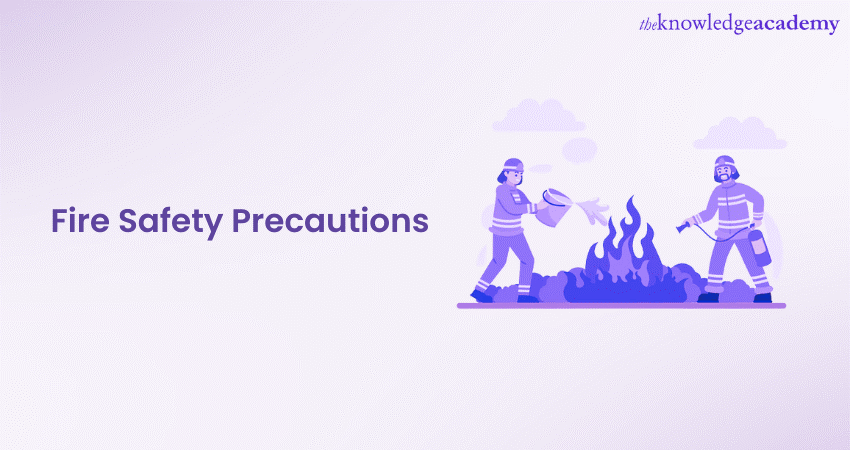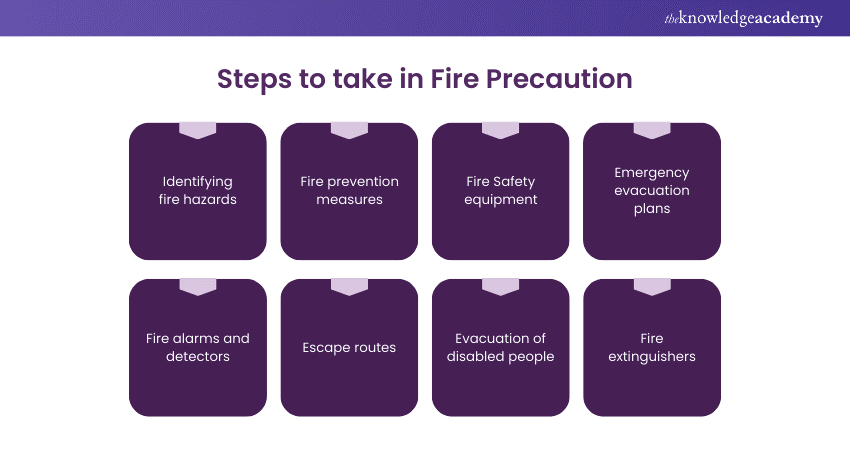We may not have the course you’re looking for. If you enquire or give us a call on 01344203999 and speak to our training experts, we may still be able to help with your training requirements.
We ensure quality, budget-alignment, and timely delivery by our expert instructors.

Fire Safety is paramount in any setting, whether homes, workplaces, or public spaces. Implementing effective Fire Safety Precautions and adhering to Fire Safety regulations can save lives and prevent catastrophic property damage.
Fire safety involves a combination of precautions, awareness, procedures and safety practices that help prevent fires and mitigate their impact if they happen. Thus, it is crucial to take precautions in the face of adversities. In this blog, we will delve into essential Fire Safety Precautions, their importance and how to create a safer environment for everyone.
Table of Contents
1) Understanding Fire Safety Precautions
a) Identifying fire hazards
b) Fire prevention measures
c) Fire Safety equipment
d) Emergency evacuation plans
e) Fire alarms and detectors
f) Escape routes
g) Evacuation of disabled people
h) Fire extinguishers
2) Importance of Fire Safety Regulations
3) Implementing Fire Safety Precautions and Regulations
4) Conclusion
Understanding Fire Safety Precautions

Understanding Fire Safety Precautions is the foundation of creating a secure and protected environment against the devastating effects of fire incidents. It involves a comprehensive awareness of potential fire hazards, implementing preventive measures, properly using Fire Safety Equipment, and formulating efficient emergency response plans. The following are some important Fire Safety Precautions:

Identifying fire hazards
The first step in Fire Safety is recognising potential fire hazards. These hazards can vary depending on the setting but may include faulty electrical wiring, improper storage of flammable materials, heating appliances, smoking, and kitchen equipment. Regular inspections and risk assessments are crucial to identify and address these hazards promptly.
Fire prevention measures
Preventing fires is the most effective way to ensure safety. Implementing fire prevention measures involves:
a) Educating individuals about safe practices, such as proper handling of electrical appliances
b) Avoiding overloading power outlets
c) Maintaining smoke detectors in working condition
Adequate housekeeping and proper storage of flammable substances are also essential in fire prevention.
Fire Safety equipment
Having the right Fire Safety equipment is essential in case of an emergency. This includes smoke detectors, fire extinguishers, fire blankets, and fire hoses. It is vital to ensure that the equipment is in good working condition, easily accessible and that occupants are trained in their proper usage.
Emergency evacuation plans
Establishing well-defined evacuation plans is critical to ensure a swift and organised response during a fire. These plans should include clearly marked escape routes, emergency exits, and designated assembly points. Additionally, a Personal Emergency Evacuation Plan can be tailored to individual needs, ensuring that everyone can evacuate safely, especially those with specific requirements.
Fire alarms and detectors
Ensuring prompt detection and warning of fires is crucial for building safety. Implement a fire alarm system that can be activated easily from any location within the premises, emitting a clear and audible signal to facilitate safe evacuation.
Regular testing, preferably weekly, is essential to maintain the effectiveness of the fire alarm system. Provide clear instructions or notices to guide individuals on operating the alarm and responding appropriately in case of an emergency.
Escape routes
Escape routes must be clearly marked and easily identifiable to facilitate swift evacuation. Display instructions for safe egress prominently along these routes and conduct regular training sessions on emergency evacuation procedures for employees.
Ensure an adequate number of exits are positioned strategically throughout the building to ensure accessibility and minimise congestion during evacuations. Conduct daily checks to ensure escape routes remain unobstructed and well-illuminated for optimal safety.
Evacuation of disabled people
Special considerations must be made for the safe evacuation of individuals with disabilities. A comprehensive fire risk assessment identifies and assesses vulnerable groups or individuals' needs.
So, develop personalised Emergency Evacuation Plans (PEEPs) tailored to the specific needs of individuals requiring assistance. Provide training for employees on implementing PEEPs effectively during emergencies to ensure the safe evacuation of all occupants, including those with disabilities.
Fire extinguishers
Understanding the principles of fire extinguishment is vital for effective fire management. Different types of fire extinguishers target specific elements of a fire—oxygen, fuel, or heat—to suppress flames. Assess the fire risks present in the premises and select appropriate extinguishers, accordingly, ensuring they are strategically located and easily accessible.
Provide visible signage to indicate the location of fire extinguishers and conduct regular training for individuals likely to use them. Ensure annual fire extinguishers are serviced to maintain operational readiness and effectiveness in combating fires.
Don't wait for an emergency! Get the Fire Safety Training for Employees PDF Guide and prepare your team.
Importance of Fire Safety Regulations
Fire Safety regulations are legal requirements and guidelines established by local and national authorities to ensure the safety of occupants in various buildings and public spaces. These regulations dictate the minimum standards for fire prevention, safety equipment, and emergency response procedures.
Fire Safety regulations govern the construction and design of buildings. They specify the use of fire-resistant materials, the installation of fire alarms, sprinkler systems, and proper ventilation to prevent the rapid spread of fire. Compliance with these building codes ensures that structures are better equipped to withstand and contain fires.
They set occupancy limits for different types of buildings based on their size and usage. These limits are determined to ensure that there is sufficient space and clear escape routes for occupants during an evacuation. Additionally, fire safety requirements for buildings may require businesses to have a designated number of fire exits and fire extinguishers, depending on the building's size and occupancy.
Fire Safety Regulations also mandate periodic inspections and audits of buildings and facilities to assess their compliance with safety standards. Regular inspections help identify potential fire hazards, ensure proper maintenance of Fire Safety equipment, and verify the effectiveness of evacuation plans.
Take the first step towards safeguarding your environment with our Fire Extinguisher Training – Click here to join now!
Implementing Fire Safety Precautions and Regulations
Instilling a Fire Safety culture is essential for maintaining a safe environment. This involves educating individuals about the importance of Fire Safety, encouraging responsible behaviour, and fostering a sense of shared responsibility for fire prevention.
Conducting regular Fire Safety training for occupants and employees is crucial. Training should include Fire Safety procedures, the proper use of Fire Safety equipment, and evacuation drills. Raising awareness through seminars, workshops, and informative materials can reinforce Fire Safety practices.
Building owners and managers should collaborate with local fire authorities to ensure compliance with Fire Safety regulations. Fire departments can provide valuable guidance, conduct safety inspections, and offer recommendations for improvement.
Conclusion
Fire Safety Precautions and regulations are fundamental in creating a safe environment for everyone. By identifying fire hazards, implementing preventive measures, and complying with Fire Safety regulations, we can significantly reduce the risk of fire incidents. Furthermore, educating individuals, conducting regular training, and fostering a Fire Safety culture ensures that everyone is adequately prepared to respond effectively in case of a fire emergency. Let us all work together to prioritise Fire Safety and protect lives and property from the devastating consequences of fire accidents.
Empower yourself with vital skills to protect lives and property – sign up for our Fire Risk Assessment Training today!
Frequently Asked Questions
Why is Fire Safety Precautions important in prevention?

Fire Safety Precautions is vital for prevention as it educates individuals on fire hazards, promoting a proactive approach. Understanding risks, properly handling flammable materials, and recognising early signs of fire enhance preparedness, reducing the likelihood of fire incidents.
How can we prevent fire from spreading?

Preventing fire spread involves swift action. Use fire-resistant materials, maintain clear escape routes, and install fire extinguishers. Regularly inspect and maintain electrical systems, educate occupants on safe practices, and conduct fire drills. Quick response and effective containment significantly mitigate the risk of fire escalation.
What are the other resources and offers provided by The Knowledge Academy?

The Knowledge Academy takes global learning to new heights, offering over 3,000 online courses across 490+ locations in 190+ countries. This expansive reach ensures accessibility and convenience for learners worldwide.
Alongside our diverse Online Course Catalogue, encompassing 19 major categories, we go the extra mile by providing a plethora of free educational Online Resources like News updates, Blogs, videos, webinars, and interview questions. Tailoring learning experiences further, professionals can maximise value with customisable Course Bundles of TKA.
What is Knowledge Pass, and how does it work?

The Knowledge Academy's Knowledge Pass, a flexible prepaid voucher system, offers the freedom to enrol in courses over a 12-month period. Start your limitless learning adventure with us and embrace education that knows no bounds.
What are related courses and blogs provided by The Knowledge Academy?

Discover an array of Fire Safety Courses at The Knowledge Academy, featuring specialised training in Fire Safety, Fire Risk Assessment, and Fire Extinguisher Training. Designed for different skill levels, our courses provide the necessary technical expertise to meet Fire Safety Systems.
Whether you're starting out or looking to upgrade your skills, immerse yourself in our Health and Safety Blogs for further understanding and expertise. Embark on a journey with us to elevate your Fire Safety Rules proficiency!
Upcoming Health & Safety Resources Batches & Dates
Date
 Fire Safety Training
Fire Safety Training
Fri 27th Jun 2025
Fri 26th Sep 2025
Fri 21st Nov 2025






 Top Rated Course
Top Rated Course


 If you wish to make any changes to your course, please
If you wish to make any changes to your course, please


